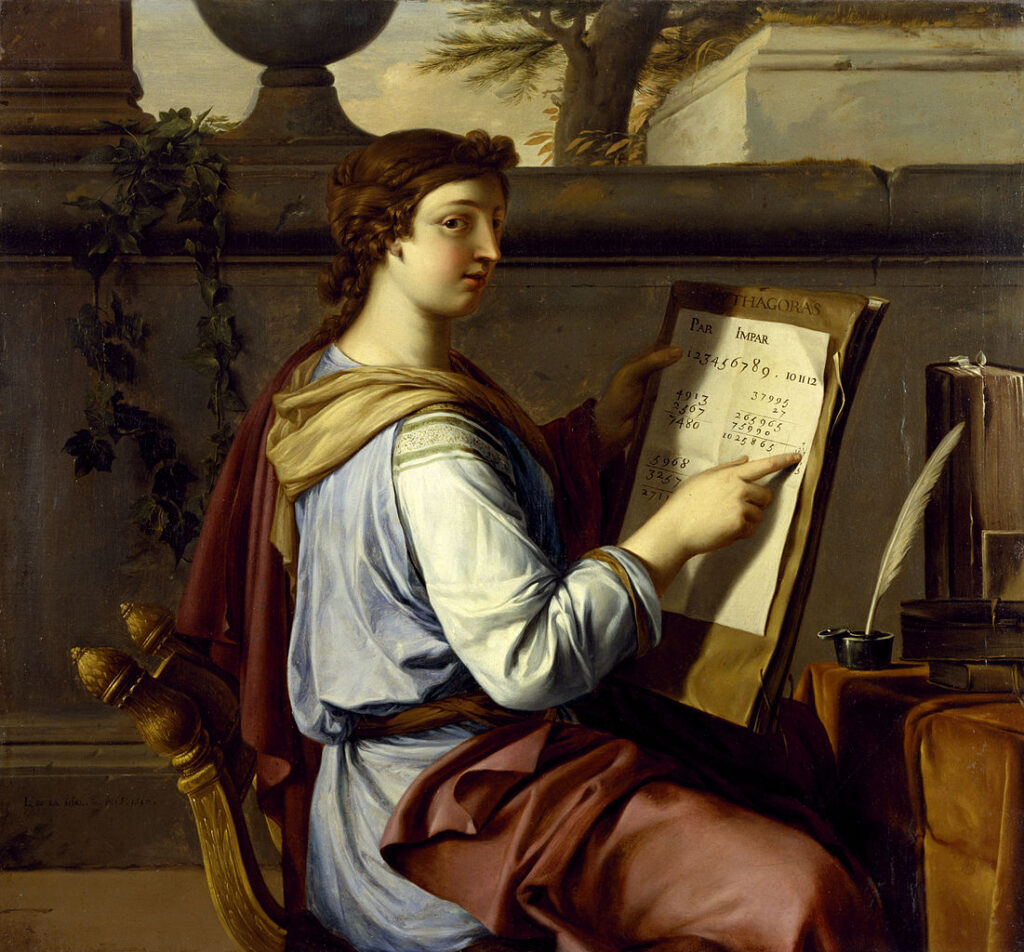
In this post I want to discuss the symbolism found in the painting “Allegory of Arithmetic” by the baroque painter Laurent de La Hyre. This painting belongs to La Hyre’s series of paintings on the liberal arts. Since Martianus Capella ( 5th century AD), the seven liberal arts were divided in trivium (grammar, logic/dialectics and rhetoric) and quadrivium (arithmetic, geometry, music and astronomy)*. In the years 1649-1650, La Hyre made an allegorical painting for each liberal art.
People can read about the history of the liberal arts paintings here [1]. In this post I want to cover the symbolism in the painting and to make some historical connections. I will go in some detail over the connection between Pythagoras and arithmetic.
Analysis
The focus of the painting is on the book and the worksheet that Arithmetic holds. On the cover of the book we can see the name Pythagoras. On the worksheet we can see the words “PAR” and “IMPAR”. On the worksheet we also see the numbers from 1 to 12 and a few basic arithmetic operations. We have the addition of two numbers (4913 + 2567= 7480), subtraction (5968 – 3257 = 2711) and multiplication (37995 x 27= 1025865).
Pythagoras is usually associated with geometry due to the Pythagorean theorem. However, Pythagoras and the Pythagoreans were very interested in arithmetic because it is the study of numbers. The study of numbers was important because Pythagoras believed that numbers are the essence of the universe. In the book “The Life of Pythagoras” by Iamblichus the following quote is given :
“Pythagoras, the son of Mnesarchus was instructed in what pertains to the Gods when he celebrated orgies in the Thracian Libethra, being therein initiated by Aglaophemus; and that Orpheus, the son of Calliope, having learned wisdom from his mother in the mountain Pangaeus, said that the eternal essence of number is the most providential principle of the universe, of heaven and earth, and of the intermediate nature; and farther still, that it is the root of the permanency of divine natures, of Gods, and divinities.”[2]
After Pythagoras, the Pythagoreans and Neopythagorans also paid attention to the study of numbers. In the book “Introduction to Arithmetic” by the Neopythagorean Nichomachus of Geresa, we have this description of arithmetic:
“Which then of these four methods (i.e, arithmetic, geometry, music and astronomy) must we first learn? Evidently , the one which naturally exists before them all, is superior and takes the place of origin and root and, as it were, of mother to the others. And this is arithmetic, not solely because we said that it existed before all the others in the mind of the creating God like some universal and exemplary plan, relying upon which as a design and archetypal example the creator of the universe sets in order his material creations and makes them attain to their proper ends; but also because it is naturally prior in birth, inasmuch as it abolishes other sciences with itself, but is not abolished together with them.” [3]
In the quote above, Nichomachus tries to explain why arithmetic is the basis of the other sciences from the quadrivium. Arithmetic, since it treats of numbers and numerical relations fundamental to the other sciences, is logically prior to them, and if it did not exist they could not exist. Arithmetic was seen as the study of number, geometry as the study of number in space, music as the study of number in time and astronomy was seen as the study of number in space and time.
The Pythagoreans went as far as having a theology of numbers. They believed that various numbers have mystical properties. Such doctrines were found in “Theology of Arithmetic” by Nicomachus of Geresa (this work didn’t survived, but it is believed that Iamblichus copied from this book in his book that bears the same title).
It is worth mentioning that the word “PAR” means even and the word “IMPAR” means odd. In his “Metaphysics”, Aristotle mentions that the Pythagoreans divided the numbers in this two categories [4]. To the Pythagoreans, the odd and even numbers were ultimately connected to the monad and the dyad, which were the most basic elements of number.
Maybe there is some symbolism behind the fact that the first twelve numbers are listed in order at the top of the worksheet. The number 12 appears in many places (astronomy, units of measure, religion etc). Between 9 and 10 there seems to be a decimal point. Maybe there are other details that are interesting that I missed.
Conclusion
I don’t know if La Hyre had in mind all these sources that I quoted above when he made the painting. He was probably not ignorant of mathematics. In fact, Laurent was a friend of Gerard Desargues, who was one of the founders of projective geometry. Laurent had a son and grandson who became mathematicians (his son was a pupil of Desargues). In the future I may do an analysis of his “Allegory of Geometry”, a painting that has more interesting details and symbolical elements. In fact, somebody already did an interesting analysis here [5].
Notes
* It was probably Boethius who divided the seven liberal arts in trivium and quadrivium. Martianus Capella wrote an allegorical work on the seven liberal arts called De nuptiis Philologiae et Mercurii (On the Marriage of Philology and Mercury)
Sources
[3] Introduction to Arithmetic by Nicomachus of Geresa
[4] Metaphysics by Aristotle
